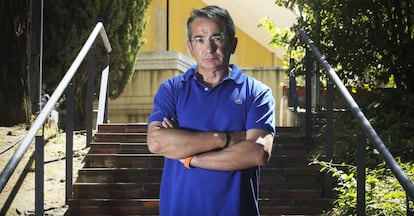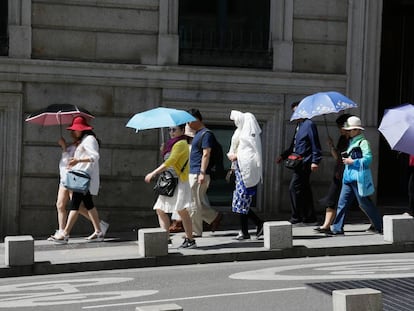“The average temperature in Madrid in summer will go from 29°C to 36°C”
Julio Díaz, who studies link between environment and mortality, discusses effects of global warming
The temperature rise on our planet is already a reality. In recent years there has not been a single summer in which the term “heatwave” was not used in the news, and we should get used to it, too, because experts feel that these weather events will be increasingly frequent and intense. Julio Díaz, head of the Epidemiology and Biostatistics department at the Carlos III Health Institute’s National School of Health, has spent several years analyzing heatwaves and their effects on the population.

Díaz’s conclusions are clear: it is nearly impossible to reverse the current situation, but it is up to us – and governments – to take steps that will make the difference between a 4ºC or 6ºC rise in the coming years.
Question. What exactly are these “heatwaves” that people talk about so much?
Answer. The truth is, there is no precise definition. From a health perspective, we describe them as a day when a threshold temperature is exceeded. But obviously these figures are not the same across the territory – which is what people used to believe – but vary instead. It depends, among other things, on what kind of heat people are accustomed to. Forty degrees Celsius is not the same for someone from Seville, who is used to such weather, and someone from A Coruña, where summer temperatures are never upwards of 28ºC or 30ºC.
In Madrid, it is estimated that average summer temperatures will reach the same as Las Vegas today, and Las Vegas is in the desert
Q. How are these threshold temperatures calculated?
A. We collect thermal data for every single day over the last 15 years at a given location, and daily mortality over the same period and in the same place. Then, using statistical tools, we determine the temperature after which mortality behaves anomalously.
Q. Is it possible to die of heat?
A. Yes, but it’s not very common. Normally, when we talk about mortality that’s attributed to high temperatures, there are very few people who die of heatstroke; rather, the people who died had other underlying conditions. For instance, for an elderly man with a cardiovascular condition, a heatwave could be fatal. That’s why we never talk about heat-caused mortality, but about an excess of mortality attributable to high temperatures.
Q. Is heat more dangerous in highly polluted cities?
A. The really dangerous thing is the pollution. The contaminated air coming out of the cars in large cities contains particulate matter that remains suspended in the air. There are studies showing that these particulates, known as Pm, and more specifically the Pm 2.5 type, are much more harmful during a heatwave.
It’s not that the weather is going to change: it is already changing. We have no choice but to adapt
Q. In 2016 we had four heatwaves. So far this year, we’ve had two and we’re not even in August yet. Will these weather events become increasingly frequent?
A. We cannot calculate this with great precision, but trends indicate that that’s the case. The atmosphere is trapping more heat because the CO2 does not let the energy from the Sun return to space. This favors increasingly extreme weather events, which means that heatwaves will be more frequent and more intense. It is estimated that the average temperature of the Earth will rise by 2ºC over the next century, but we need to consider that this increase will not be gradual, but occur in peaks. So we will be dealing with periods of very high temperatures with back-to-back heatwaves, and cold waves with very low temperatures.
Q. When you talk about a 2ºC rise, do you mean that summers in Madrid will go from an average 28ºC to an average 30ºC?
A. Not exactly. When we talk about a 2ºC rise, that’s the average temperature for the entire planet, but the planet has land and sea. The bad part is that water has a very high specific heat capacity – the amount of heat you must apply to heat a gram of water. So if water temperature rises by 2ºC, that means that on land the increase will be at least 6ºC. In Madrid, it is estimated that average summer temperatures will rise from 28.8ºC to 36ºC, so 8ºC more. We would reach the same temperatures as Las Vegas today, and Las Vegas is in the desert.
Q. Can we backpedal?
A. No. The temperature rise is unstoppable. Even if CO2 emissions were reduced to zero right now, it would still take thousands of years to go back to earlier temperatures. What we can do is decide whether we want this rise to be moderate, or whether we want it to continue at the present rate.
People who have received immunization against certain diseases will be in contact with others who have not
Q. What is your opinion of the US president’s statements that climate change and global warming are a hoax, and his decision to pull out of the Paris agreements?
A. Climate change is here, that is undeniable. You burn coal as a fossil fuel and you release CO2 into the atmosphere. If you keep burning fossil fuels, you will keep releasing CO2 into the atmosphere. The Paris agreements are not the cure-all – they talk about a 2ºC increase in average temperatures – but that’s always better than the 8ºC we are facing if we don’t do something.
Q. How are our everyday lives going to change with this temperature rise?
A. It’s not that it’s going to change: it is already changing. We have no choice but to adapt. A lot of progress is being made on bioclimatic architecture that will help regulate the temperature of homes so that the heat is more bearable. In any case, in my view, the rise in temperature is not the main problem we will see from climate change.
Q. It isn’t? What is then?
A. Population migrations, without a doubt. If you live in a country where it doesn’t rain, where the heat is unbearable and where, as a result of rising sea levels, the most fertile areas in the river valleys have been flooded and you can no longer grow food to eat, what are you going to do? Starve to death? Those people will have no choice but to emigrate. And where will they go? To the countries in the north. And these people will logically move to the cities. Right now, an estimated 56% of the world population already lives in big cities. If we add the climate refugees, we will end up with overpopulated mega-cities. And this will exacerbate pre-existing problems such as pollution or the heat islands that many cities have already become.
Q. If we reduced the amount of pollutants we release into the atmosphere and made cities more efficient, would this population increase still be a problem?
A. There will be other types of problems, such as health-related ones. You need to consider that people who have received immunization against certain diseases will be in contact with others who have not. And you could see social and security problems flare up when you have very densely populated cities.
English version by Susana Urra.
Tu suscripción se está usando en otro dispositivo
¿Quieres añadir otro usuario a tu suscripción?
Si continúas leyendo en este dispositivo, no se podrá leer en el otro.
FlechaTu suscripción se está usando en otro dispositivo y solo puedes acceder a EL PAÍS desde un dispositivo a la vez.
Si quieres compartir tu cuenta, cambia tu suscripción a la modalidad Premium, así podrás añadir otro usuario. Cada uno accederá con su propia cuenta de email, lo que os permitirá personalizar vuestra experiencia en EL PAÍS.
¿Tienes una suscripción de empresa? Accede aquí para contratar más cuentas.
En el caso de no saber quién está usando tu cuenta, te recomendamos cambiar tu contraseña aquí.
Si decides continuar compartiendo tu cuenta, este mensaje se mostrará en tu dispositivo y en el de la otra persona que está usando tu cuenta de forma indefinida, afectando a tu experiencia de lectura. Puedes consultar aquí los términos y condiciones de la suscripción digital.










































